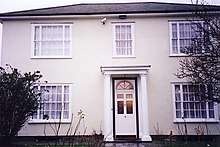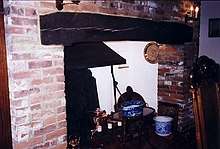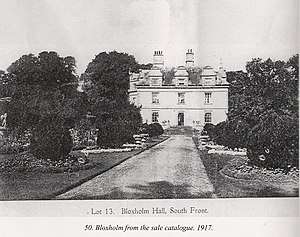Mary Ann Mansel
Mary Ann Mansel, also known as Mary Ann Goodchild, (before 26 October 1780 – 26 October 1854) was a well-connected figure in the Georgian period. She became best known for having long-term relationships with two senior British Army officers, General Robert Manners, who was Equerry to King George III, and General Sir Charles Asgill, Equerry to Frederick, Duke of York.
Biography
_from_Lucy_and_Mary_Ann_Mansel_to_Herbert_Mansel%2C_Charles_Childs_closest_sibling.jpg)
Born in Waterford, Ireland, Mary Ann made her life in London and was soon settled in a long-standing relationship with General Robert Manners, a grandson of John Manners, 2nd Duke of Rutland, who was equerry to King George III.[1]
They had six children, all baptised at St. George's, Hanover Square:
- Robert Mansel (1802–1879) was commissioned as a cornet in the 6th (Inniskilling) Dragoons in May 1819.[2] He was promoted to lieutenant in June 1825[3] and captain in July 1827,[4] and retired in April 1837.[5] In October 1853 became a lieutenant in the Hampshire Militia Artillery,[6] being promoted to captain in December that year[7] and major in July 1869.[8] In January 1872 he resigned his militia commission and was granted the honorary rank of lieutenant-colonel.[9]
- George Mansel (1804–1844) was commissioned as ensign in the 30th (Cambridgeshire) Regiment of Foot in September 1820.[10] He was promoted lieutenant in December 1825[11] and captain in August 1829.[12] In November 1832 he transferred to a captaincy in the 16th Light Dragoons,[13] holding that rank until his death.[14]
- William Henry Mansel (1807–1812)
- Lucy Mansel (1810–1876)
- (William) Herbert Mansel (1812–1889) joined the 30th Foot as an ensign in June 1830[15] and was promoted to lieutenant in January 1834.[16] He then became adjutant and lieutenant in the 6th Dragoons in June 1834.[17] In February 1841 he transferred to the 61st Regiment of Foot as lieutenant,[18] then in June 1843 exchanged to a lieutenancy on the half-pay list of the 16th Regiment of Foot.[19] Finally, in July 1846, he transferred to the Ceylon Rifle Regiment as a first lieutenant, retiring the same day.[20]
- Henry Edward Mansel (1818–1820)


Before Henry Edward was born, Mary Ann gave birth to a son by General Sir Charles Asgill, equerry to Frederick, Duke of York. They named him Charles Childs (1816–1884). His first name was the name of his father and grandfather (Sir Charles Asgill, a one-time Lord Mayor of London). Childs was possibly chosen as the surname using the last syllable of Mary Ann’s maiden name of Goodchild. In the Kelly's Court Directory of 1866–1867 Charles Childs is listed as a Hop Grower in Loose and Staplehurst, unlike his half-siblings, the Mansel children, who chose a military path, Mary Ann's three surviving sons all having joined the army.[21]
When Charles Childs was born in 1816 he was in danger of death. As a Roman Catholic Mary Ann felt it her duty to ensure he had been baptised. She engaged the services of Charles Edouard Drummond, 5th Earl and Duke of Melfort and 10th Duke of Perth (1752–1840), titular 13th Earl of Perth, "Abbé de Melfort" to perform the baptism urgently at home. These events are recorded in "Father’s Book, Members of the Family" (written by two of Charles Childs's sons), and this book remains with a descendant living in Mary Ann's home city of Waterford.[22]
On 9 September 1818 the trial of Richard Wheeler took place at the Old Bailey.[23] He had stolen a hog from Mary Ann and although he returned the hog he was deported to Australia for 7 years. The trial proceedings revealed Mary Ann’s name and address in Chelsea (which was very close to the Man in the Moon public house).[24]
Mary Ann Mansel's Sun Fire Insurance cover increased substantially in 1821 (just 4 months after she had already renewed it).[25] This coincided with General Sir Charles Asgill selling his York Street house, his wife, Sophia, having died in 1819.[26] Asgill moved in with Mary Ann that year and wrote two codicils from her home in the days before his death.[27] One of these codicils bequeathed a clock and two vases to Mary Ann and his black mare he left to Mary Ann’s son Herbert.[27] The terms of Sir Charles Asgill, 1st Baronet's will were such that, should his son, General Sir Charles die childless (he did, having no legitimate heirs) then, in those circumstances, he must leave everything he owned to his sisters, nieces and nephews. The General therefore had no choice and could leave nothing to Mary Ann or their son Charles Childs.[28] Interestingly, having spent the final two years of his life with Mary Ann, when Asgill died on 23 July 1823 his obituary appeared in The Gentleman’s Magazine: 1823, Volume 93, Part 2;[29] This magazine carefully did not mention his place of death, which is very uncommon for a notable personage. It would seem discretion was the better part of valour.
When both Mary Ann’s lovers died in 1823 she fell to pieces and her surviving four Mansel children became wards of Manners’ brother George (1763–1828) and sister Mary Nisbet (1756–1834). There is an 1828 court case here[30] which mentions the wardship; mentions the late General Robert Manners; Mary Ann Mansel (who had to give evidence), and her surviving Mansel children, and also mentions Robert Manners' sister Mary and brother George. It appears they were fighting over who got what from Robert Manners' will. She kept only Charles Childs with her, before she eventually left London and firstly moved to Sutton Valence, then Lenham in Kent. She finally moved to Loose (near Maidstone in Kent). She had disposed of her house at 15 Park Place South, Chelsea, now known as Park Walk [31] (which had been provided for her by Robert Manners) (this house was bombed in World War II) and she purchased Hill House in Loose, Kent.[32][22] She is found on the 1851 census (HO 107-1616 - page 19 folio 440) as being at Loose Hill, Maidstone, Kent with Charles Childs, his wife Elizabeth and four of their children. The house was large and probably needed in order to accommodate the growing family. Astonishingly, Charles Childs is listed as a 'visitor', although he lived with her his entire life until her death.[33]
It is believed that Mary Ann's move from London to Kent was to be near one of her Mansel sons. When her Mansel children had become wards of the Manners family it split the family permanently and the younger ones, in particular, became nomadic, spending their time either at boarding school, at Manners' homes in London or at Bloxholm Hall in Lincolnshire. They never became a tight family unit again although they wrote to one another often and always went to visit Mary Ann as frequently as they could. In his will Robert Manners left Mary Ann a considerable inheritance making her a wealthy woman in her own right. Manners also provided for his children.[34] While Herbert caused his father, and the rest of the family, much worry with regard to his behaviour, they all ended up having successful lives and careers. Descendants of Robert Mansel, in New Zealand, kept the General's frock coat buttons (inlaid in a coffee table), and Herbert's descendants in England have kept 21 letters written by his siblings, mother and father.[35]

At the time Mary Ann made her last will and testament[37] only three of her Mansel children still survived. However, she left everything she owned, including Hill House in Loose (which still stands), to her son Charles Childs. He was her sole Executor. In keeping with her subterfuge even under these circumstances she does not acknowledge Charles as her son - simply her sole Executor and sole Beneficiary. It is not known when Charles Childs entered a relationship with Elizabeth Hayward (1823–1895) – although no marriage certificate has been found it is believed they were married. Together they had 11 children, the first four having been born before Mary Ann died (as can be seen from the census return). Their first-born, a daughter named Mary Ann Childs, died soon after her fifth birthday. After Mary Ann Mansel died, on 26 October 1854, her death certificate records her as being the "widow of Robert Mansel, Gentleman", a ploy used to continue to hide her tracks. Were it not for the remaining family letters, which make the real situation known (and General Manners is described as the father of her children by his sister (Mary Hamilton Nisbet), and others) her secrets might not have been revealed. She was buried at All Saint’s Church, Loose[38] and thirty years later, in 1884, Charles Childs was buried in her grave there too. Prior to his death Charles Childs was admitted to the Lunatic Asylum at Barming Heath, suffering from dementia, all his family having abandoned him.[1]
In George III, A Personal History, by Christopher Hibbert on page 299 it is recorded:[39]
- Such was the tribute of popular attachment manifested in March 1789 towards a sovereign who, only seven years earlier, in March 1782, after losing a vast empire beyond the Atlantic, seemed to stand on a fearful precipice. [To celebrate the king's return to health] There were balls at the Pantheon and at the Duke of York's. A fête was held by White's, where Colonel Manners, who had taken over as equerry on the expiration of Colonel Greville's tour of duty, sang 'God Save the King' so lustily that he was asked not to be so loud. 'They pretended I was out of tune,' Manners said. 'But it was in such a good cause I did not mind.'
The diarist, Fanny Burney, recorded recollections regarding Robert Manners.[40]
Manners' family seat was Bloxholm Hall in Lincolnshire.[41]

References
- Kingsley, Nick (2015-12-02). "Landed families of Britain and Ireland: (197) Asgill of Asgill House, Richmond, baronets". Landedfamilies.blogspot.com. Retrieved 2019-10-27.
- "No. 17483". The London Gazette. 5 June 1819. p. 976.
- "No. 18149". The London Gazette. 25 June 1825. p. 1105.
- "No. 18385". The London Gazette. 7 August 1827. p. 1682.
- "No. 19488". The London Gazette. 28 April 1837. p. 1079.
- "No. 21487". The London Gazette. 21 October 1853. p. 2829.
- "No. 21509". The London Gazette. 6 January 1854. p. 45.
- "No. 23523". The London Gazette. 6 August 1869. p. 4367.
- "No. 23820". The London Gazette. 19 January 1872. p. 197.
- "No. 17634". The London Gazette. 16 September 1820. p. 1760.
- "No. 18201". The London Gazette. 10 December 1825. p. 2253.
- "No. 18605". The London Gazette. 25 August 1829. p. 1590.
- "No. 18995". The London Gazette. 16 November 1832. p. 2524.
- "No. 20425". The London Gazette. 20 December 1844. p. 5230.
- "No. 18689". The London Gazette. 11 June 1830. p. 1158.
- "No. 19120". The London Gazette. 17 January 1834. p. 102.
- "No. 19168". The London Gazette. 27 June 1834. p. 1212.
- "No. 19956". The London Gazette. 26 February 1841. p. 517.
- "No. 20232". The London Gazette. 9 June 1843. p. 1934.
- "No. 20625". The London Gazette. 24 July 1846. p. 2714.
- Kelly's Court Directory of 1866-1867
- "Father’s Book, Members of the Family"
- "Browse - Central Criminal Court". Oldbaileyonline.org. Retrieved 2019-10-27.
- "Man in the Moon | London | London pubs, British pub, London england". Pinterest.co.uk. Retrieved 2019-10-27.
- "Insured: Mary Ann Mansell 15 Park Place South near The Man in the Moon Chelsea | The National Archives". Discovery.nationalarchives.gov.uk. Retrieved 2019-10-27.
- "Duke of York Street | British History Online". British-history.ac.uk. Retrieved 2019-10-27.
- "Will of Sir Charles Asgill of York Street Saint James's Square in the City of... | The National Archives". Discovery.nationalarchives.gov.uk. Retrieved 2019-10-27.
- "Will of Sir Charles Asgill of Cork Street Burlington Gardens , Middlesex | The National Archives". Discovery.nationalarchives.gov.uk. Retrieved 2019-10-28.
- "Sir Charles Asgill, Bart". Obituary. The Gentleman's Magazine (September): 274–275. 1823.
- "[W1829 M1]. Mansel v Mansel. Bill and two answers. Plaintiffs: Robert Mansel and others | The National Archives". Discovery.nationalarchives.gov.uk. Retrieved 2019-10-27.
- "Park Walk Guide | Park Walk, Chelsea, London SW3 | Nearby hotels, shops and restaurants". LondonTown.com. Retrieved 2019-10-29.
- "Hill House, Loose". British Listed Buildings. Retrieved 26 October 2019.
- 1851 census (HO 107-1616 - page 19 folio 440)
- "Will of Robert Manners, General in His Majesty's Service of Bloxholm , Lincolnshire | The National Archives". Discovery.nationalarchives.gov.uk. Retrieved 2019-10-27.
- "Extracted: two letters and two post scripts from 21 letters written to Herbert Mansel (by family members) in the 19th century" (PDF). Retrieved 19 December 2019.
- "Loose | Kent Archaeology Society". Kentarchaeology.org.uk. Retrieved 2019-12-18.
- "Will of Mary Ann Mansel, Gentlewoman of Loose , Kent | The National Archives". Discovery.nationalarchives.gov.uk. Retrieved 2019-10-27.
- "History". All Saint’s Church, Loose. Retrieved 2019-10-27.
- Hibbert, Christopher (1999). George III, A Personal History London: Penguin. p. 299 ISBN 978-0140257373
- "1788 to 1796: 1788-1796 - Fanny Burney - Google Books". Books.google.co.uk. Retrieved 2019-10-27.
- "Sketches, illustrative of the topography and history of new and old Sleaford - James Creasey - Google Books". Books.google.co.uk. Retrieved 2019-10-27.